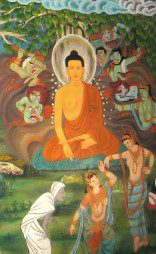The practice of Buddhism throughout the world seems to adapt to the culture of the country of import. A variety of cultures merge beliefs with different dharma focuses, such as ethics and morals, science, meditation, and psychology. The practice of Buddhism can vary, just as Christianity does for Catholics, Lutherans, Methodists, Baptists, and Christian Scientists. There are two basic Buddhist traditions: Theravada and Mahayana.
As Buddhism spread south from the north of India, the original tradition, Theravada, encompassed most of India, Sri Lanka, Thailand, Burma (Myanmar), Cambodia, and Laos. Today, only three countries are considered “Buddhist countries.” They are Sri Lanka, Thailand, and Burma (Myanmar).
As Buddhism spread north to include Nepal, Tibet, Bhutan, Vietnam, China, Korea, and Japan, there were changes in some of the practices, and the more liberal Mahayana tradition was the result. However, Mahayana is divided into several schools, which today include Vajrayana, Pure Land, and Zen, although there are others.
Some consider Vajrayana a tradition rather than a school, mainly because in Tibet, Buddhism merged with that culture’s ancient and indigenous religion of Bon. Tantra became influential in Nepal, Tibet, China, Japan, Java, and Sumatra (Indonesia). Ch’an or Zen, the meditation school, became popular in China and Japan. Soka Gakkai began in Japan but has spread into the West, and Pure Land has roots in Tibet and China and is growing in the West. Both Zen and Vajrayana are growing in popularity in the West.
Both of these traditions and all of the schools can be found in the United States. Sometimes, the different practices of Buddhism, such as Korean Buddhism, Japanese Buddhism, Thai Buddhism, Tibetan Buddhism, etc., are incorrectly labeled ethnically or culturally. This is because as Buddhism spread to these different countries and cultures, it absorbed some of each country’s traditions, ceremonial customs, and indigenous religious philosophies and beliefs.
It is important to understand, however, that the basic Buddhist teachings of the Four Noble Truths and the Eightfold Path, which include but are not limited to, the teachings of karma and samsara, are basically the same in all traditions and schools. Methods of practice, explanations of dharma, and some interpretations may differ, but the importance of practicing metta and karuna (loving kindness and compassion with action) is stressed by the sangha and all dharma teachers in each tradition and in all schools.

